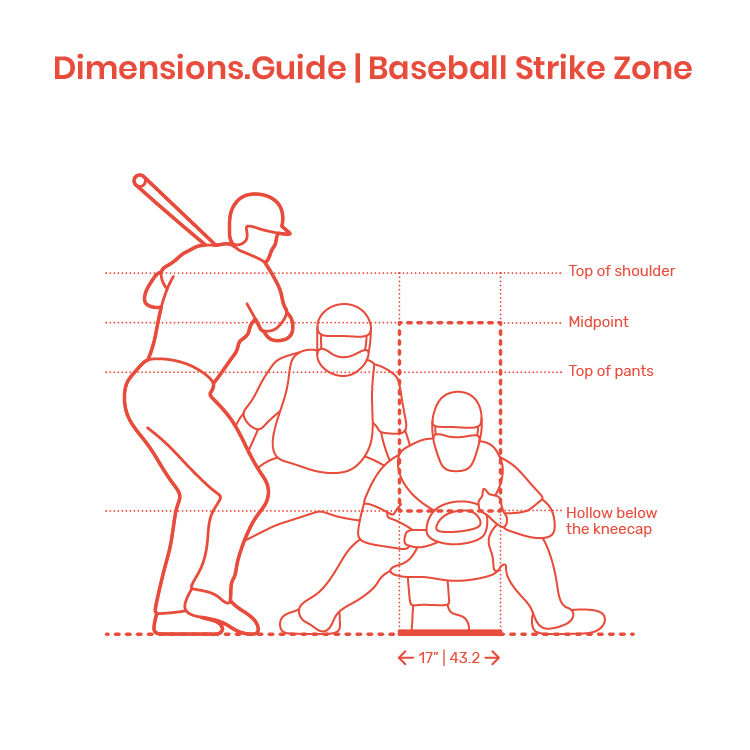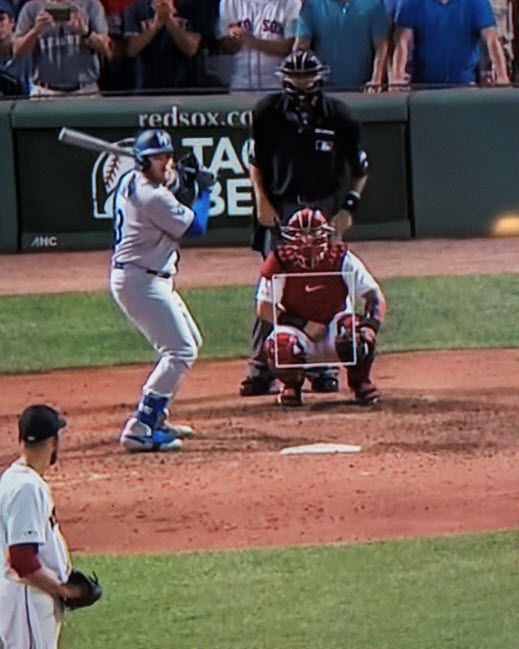Strike Zone in Baseball
Oct 24, 2022 10:08:42 #
The Definition of the Strike Zone in MLB is:
“The official strike zone is the area over home plate from the midpoint between a batter's shoulders and the top of the uniform pants -- when the batter is in his stance and prepared to swing at a pitched ball -- and a point just below the kneecap. In order to get a strike call, part of the ball must cross over part of home plate while in the aforementioned area.”
This is verified by the many diagrams of the Strike Zone via Google. One such diagram is shown below.
When I was a young boy in Little League many many moons ago, we were instructed that the strike zone is from the letters (chest level) to the knees, which matches pretty much with the above definition. Yet, when we see on TV the Strike Zone BOX (second image below), it shows the top of the zone to be at BELT level and not at CHEST level. And if the pitch is above the line, the ump typically calls it a ball. So why is the top of the BOX on TV at belt level?
“The official strike zone is the area over home plate from the midpoint between a batter's shoulders and the top of the uniform pants -- when the batter is in his stance and prepared to swing at a pitched ball -- and a point just below the kneecap. In order to get a strike call, part of the ball must cross over part of home plate while in the aforementioned area.”
This is verified by the many diagrams of the Strike Zone via Google. One such diagram is shown below.
When I was a young boy in Little League many many moons ago, we were instructed that the strike zone is from the letters (chest level) to the knees, which matches pretty much with the above definition. Yet, when we see on TV the Strike Zone BOX (second image below), it shows the top of the zone to be at BELT level and not at CHEST level. And if the pitch is above the line, the ump typically calls it a ball. So why is the top of the BOX on TV at belt level?

Every Strike Zone BOX on TV shows top to be at BELT level...wonder why?

Oct 24, 2022 10:11:37 #
Oct 24, 2022 10:18:35 #
Guyserman
Loc: Benton, AR
jpwa wrote:
Because that's where it is today. Get over it.
It's a curiosity. I'd kinda like to know. But I'm not hung up on it. Nothing to get over.
Oct 24, 2022 10:25:00 #
jpwa wrote:
Because that's where it is today. Get over it.
That's kind of a harsh response for a question about modern day baseball.
Oct 24, 2022 11:31:52 #
Oct 24, 2022 11:43:55 #
Triple G wrote:
What counts is how the umpire calls them and that he does it consistently.
Most umps in MLB are consistent. If the pitch is at the chest level, which should according to definition be a strike, the ump calls it a ball consistent with the TV Strike Zone Box.
Oct 24, 2022 13:32:53 #
bobbyjohn wrote:
Most umps in MLB are consistent. If the pitch is at the chest level, which should according to definition be a strike, the ump calls it a ball consistent with the TV Strike Zone Box.
I have never seen a strike zone on the TV screen with the top of the zone at belt level. It is always higher.
There is talk of major league baseball using the strike zone box for balls and strikes automatically with no input from the umpire. The technology exists for such a change.
Next year pitchers and batters will be on a "shot clock". They used it this year in the minor leagues and it cut the time of games by about 25 minutes.
Also coming next year...no defensive shifts allowed. There must be two infielders each side of 2nd base and their feet must be on the dirt portion of the infield...not shallow outfield.
Oct 24, 2022 17:22:29 #
Just Shoot Me
Loc: Ithaca, NY
Also from Google
"Has the strike zone gotten smaller?
Consequently, the zone was shrunk in 1969 to now span from the batter's armpits to the top of his knees. It shrunk again in 1988 to span from the midpoint between the shoulders and belt (the letters) and top of the knees."
Don't know if this helps or hinders.
Could it be the perspective of the camera angle and the projected "box" on the TV screen?
"Has the strike zone gotten smaller?
Consequently, the zone was shrunk in 1969 to now span from the batter's armpits to the top of his knees. It shrunk again in 1988 to span from the midpoint between the shoulders and belt (the letters) and top of the knees."
Don't know if this helps or hinders.
Could it be the perspective of the camera angle and the projected "box" on the TV screen?
Oct 25, 2022 00:13:18 #
two interesting things.
When we see the little box on TV, we see the ball all the way from the pitcher's hand to the catcher's glove. If it is a curve ball, slider, sinker, whatever, there is no way for us to know exactly where the ball is when it goes over the plate. Granted there is not much distance between the center of the plate and the catcher's glove, but still...something to think about.
I learned something while watching the Yankees/Astros game last night. Based on the commentator, a talented catcher can place his glove differently than would be expected to catch the ball. In other words, he might catch the ball in the palm of the glove rather than the web. This can fool the umpire as to where the ball actually was when it came over the plate. The first surprise was that the umpire would pay attention to the catcher's catch, rater than focusing on the plate itself, but it makes sense when you think about it...the action is way slowed at the catch.
But the second thing learned is that the catcher could actually fool the umpire with the catching.
I was impressed.
When we see the little box on TV, we see the ball all the way from the pitcher's hand to the catcher's glove. If it is a curve ball, slider, sinker, whatever, there is no way for us to know exactly where the ball is when it goes over the plate. Granted there is not much distance between the center of the plate and the catcher's glove, but still...something to think about.
I learned something while watching the Yankees/Astros game last night. Based on the commentator, a talented catcher can place his glove differently than would be expected to catch the ball. In other words, he might catch the ball in the palm of the glove rather than the web. This can fool the umpire as to where the ball actually was when it came over the plate. The first surprise was that the umpire would pay attention to the catcher's catch, rater than focusing on the plate itself, but it makes sense when you think about it...the action is way slowed at the catch.
But the second thing learned is that the catcher could actually fool the umpire with the catching.
I was impressed.
Oct 25, 2022 05:51:40 #
bobbyjohn wrote:
The Definition of the Strike Zone in MLB is: br ... (show quote)
Does anyone notice the catcher looks like Gort, from "The Day the Earth Stood Still"
Oct 25, 2022 08:14:57 #
The strike zone might look lower because the camera is aimed down from a higher position. The umpire sees the ball at eye level.
Oct 25, 2022 09:55:56 #
The reality is that no two umpires have exactly the same strike zone. As was mentioned above, consistency is the key. If the umpire is consistent, the batter can adjust to his strike zone.
Oct 25, 2022 10:08:17 #
I'm not up on the latest baseball rules, but this wouldn't be the first time that TV has led people astray. It's one thing to have that box positioned there and watch the ball travel in slow motion. It's quite another to be standing behind the catcher watching hundreds of pitches come flying over the plate and making an instant decision.
This is why I never liked the idea of instant replay to see the referee or umpire made the right call. By definition, he made the right call. If we want to use electronics, then we can eliminate the ref and ump and replay everything in slo-mo. A computer can announce the winner at the end of the game.
This is why I never liked the idea of instant replay to see the referee or umpire made the right call. By definition, he made the right call. If we want to use electronics, then we can eliminate the ref and ump and replay everything in slo-mo. A computer can announce the winner at the end of the game.
Oct 25, 2022 10:20:21 #
fredtoo wrote:
...a talented catcher can place his glove differen... (show quote)
I was a catcher in High School. The thing about the catcher trying to fool the ump is referred to as "pulling a ball back into the strike zone." You see this constantly in MLB on TV, and it rarely works. MLB umpires are smart enough not to fall for any catcher antics to try to fool them...a good ump calls it based on where it passes the plate, not on the catcher pulling a ball. In addition, I don't think a catcher can nor wants to position his glove into the strike zone before catching it...too much risk of a passed ball.
Oct 25, 2022 10:48:40 #
fredtoo wrote:
two interesting things. br br When we see the lit... (show quote)
I think catchers have been doing that for a while. The good ones make it an art.
If you want to reply, then register here. Registration is free and your account is created instantly, so you can post right away.


